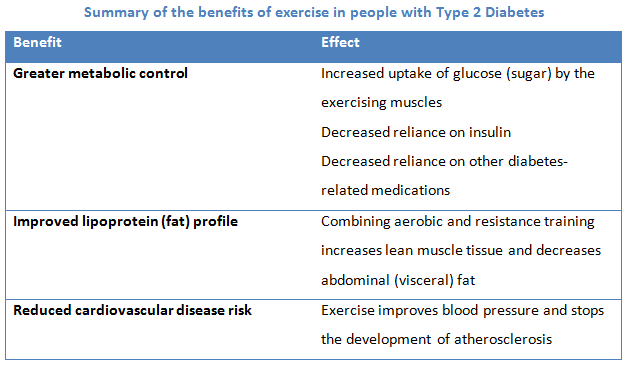Type 2 Diabetes has reached epidemic proportions in our community, with the prevalence of diabetes increasing over 90% in the last 10 years in Boroondara alone. This is staggering when you consider that 60% of Type 2 Diabetes cases can be prevented with lifestyle modifications. In particular, exercise not only reduces the risk of developing diabetes, it also slows the progression of the disease and can decrease the risk of cardiovascular disease. Therefore, physical activity should be prescribed to all people with Type 2 Diabetes to help improve their quality of life.
Benefits of exercise for those with Type 2 Diabetes
 Greater metabolic control: improved glucose control and decreased insulin resistance
Greater metabolic control: improved glucose control and decreased insulin resistance
Our bodies rely on insulin to move sugar (glucose) from our blood stream into our muscles. In people with Type 2 diabetes, the action of insulin is affected. Exercise mediates this by promoting the movement of glucose into the blood stream through a pathway that is independent of insulin, therefore decreasing blood sugar levels. The decrease in blood glucose levels has been associated with a reduction in the risk of diabetes-related complications (e.g., heart disease), with lifestyle modification being more effective than medication for these healthy changes.
An improved lipoprotein (fat) profile and weight loss
Weight loss and an increase in muscle mass are two very important benefits of exercise for those with Type 2 Diabetes. A high amount of visceral fat (e.g., abdominal fat) is associated with an increased risk of heart disease and Type 2 Diabetes. Decreasing abdominal fat also improves glucose control. A combination of aerobic and strength training helps to maintain weight loss in the long term by increasing your lean muscle tissue.
Reduced risk of cardiovascular disease
Cardiovascular disease is extremely common in those with Type 2 Diabetes. In fact, it accounts for over 50% of deaths in this population. Cardiovascular disease can occur as a result of poor glucose control over a period of time, creating atherosclerosis and causing heart attacks. Exercise is a powerful factor in reducing cardiovascular disease in all populations, and this is particularly the case in those with Type 2 Diabetes. Exercise improves blood pressure and the function of the heart, as well as reducing abdominal fat.

Exercise considerations for those with Type 2 Diabetes
 The risk of a cardiovascular event occurring in a person with Type 2 Diabetes during exercise is small, with the benefits of exercise far outweighing any risks. However, the presence of artery disease does increase the risk of a cardiac event occurring. Therefore, it is recommended that people with Type 2 Diabetes get a referral from their GP and undergo an appropriate stress test before commencing exercise, to determine if there are any artery issues.
The risk of a cardiovascular event occurring in a person with Type 2 Diabetes during exercise is small, with the benefits of exercise far outweighing any risks. However, the presence of artery disease does increase the risk of a cardiac event occurring. Therefore, it is recommended that people with Type 2 Diabetes get a referral from their GP and undergo an appropriate stress test before commencing exercise, to determine if there are any artery issues.
Hypoglycaemia (low blood glucose levels) can occur during and after exercise in people with Type 2 Diabetes. Before undertaking any exercise, we recommend that you are educated on the best way to fuel your body before and after each exercise session. Working with an Exercise Physiologist will help you to understand how best to time and select your meals given your activity levels. As your muscles will increase their uptake of glucose from the blood stream, it is important that you eat a substantial meal before exercise to ensure hypoglycaemia does not occur. Your muscles will continue to remove glucose from the blood stream at an increased rate for up to 2 hours after the exercise session has finished, so it is imperative that something substantial is also eaten immediately after each session. A readily-available supply of glucose should be kept close by at all times when exercising.
Exercise recommendations for people with Type 2 Diabetes
The greatest benefits of exercise for those with Type 2 Diabetes are gained when combining resistance training with aerobic training. A combination of the two forms of exercise has been shown to not only improve metabolic control, but also to reduce cardiovascular disease risk. Completing a combined program will also enhance the effect of exercise by providing other benefits such as weight loss, lean muscle tissue gains, strength gains, and increased cardiovascular fitness.

It should also be noted that whilst aerobic and resistance training will provide great benefits for diabetes control and cardiovascular disease risk, balance, stability, and postural strength are also key elements of any well-rounded training program.
Many people who haven’t exercised for a long period of time or lead a sedentary life can also experience musculoskeletal pain or injuries. This particular population can be at an increased risk of injury when completing exercise, due to existing postural imbalances that are likely to cause musculoskeletal pain. Putting load through a body which is not properly conditioned can further exacerbate any existing imbalances and injuries, potentially decreasing an individual’s motivation and ability to complete an exercise program effectively and pain-free. As there are already many barriers to exercise for people with Type 2 Diabetes, it is extremely important that a healthy musculoskeletal system is restored and then maintained. Therefore, we believe it is important to include an element of corrective exercise in any program undertaken to improve diabetes and cardiovascular disease, to ensure that our clients can exercise safer for longer. At Inspire Fitness, we assess each individual and determine any musculoskeletal or postural issues that need to be addressed in their exercise program before progressing you further.
Summary
The continued growth of Type 2 Diabetes in our society is concerning, as the burden is placed not only on those with the disease, but also on the health care system. Exercise has been unequivocally demonstrated to improve all aspects of Type 2 Diabetes, as well as being highly effective for preventing the onset of the disease. There are some considerations that need to be taken into account before commencing an exercise program, and it is best to see your GP before commence an exercise program. A combination of aerobic and resistance training has been found to be the most effective way to maintain good metabolic control and to improve many other important health markers in diabetes. Although a combined aerobic and resistance training program will improve Type 2 Diabetes and associated cardiovascular disease risk factors, it should be noted that corrective exercises are important in maintaining each individual’s longevity in exercise.
